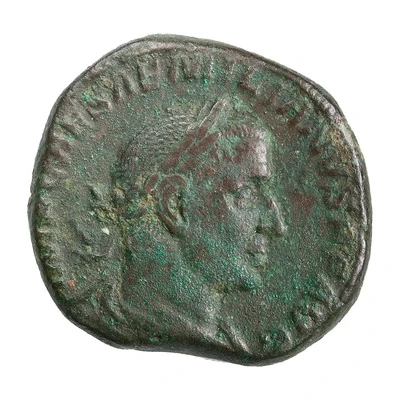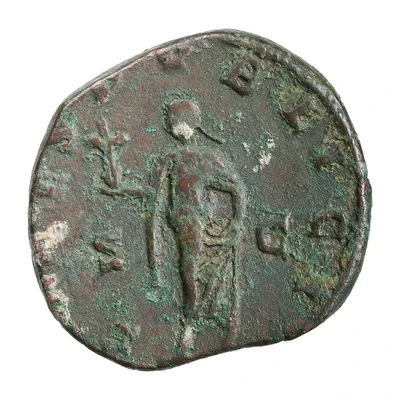Sestertius - Aemilianus ROMAE AETERNAE S C; Roma
253 year| Bronze | - | - |
| Issuer | Rome › Roman Empire (27 BC - 395 AD) |
|---|---|
| Emperor | Aemilianus (Marcus Aemilus Aemilianus) (253) |
| Type | Standard circulation coin |
| Year | 253 |
| Value | Sestertius (⅛) |
| Currency | Antoninianus, Reform of Caracalla (AD 215 – 301) |
| Composition | Bronze |
| Shape | Round (irregular) |
| Technique | Hammered |
| Demonetized | Yes |
| Updated | 2024-10-05 |
| Numista | N#284729 |
|---|---|
| Rarity index | 100% |
Reverse
Roma, helmeted, draped, standing left, holding phoenix on globe in right hand and spear in left hand; to her right, shields.
Script: Latin
Lettering: ROMAE AETERNAE S C
Translation:
Romae Aeternae. Senatus Consultum.
Everlasting Rome. Decree of the senate.
Comment
Source:Online Coins of the Roman Empire (OCRE)
Interesting fact
The Sestertius - Aemilianus coin was minted during the reign of Emperor Aemilianus, who ruled the Roman Empire for a brief period of time in 253 AD. Despite his short reign, Aemilianus was able to issue a large number of coins, including the Sestertius - Aemilianus, which was used to pay soldiers and civil servants. The coin features an image of the Roman goddess Roma on the obverse (front side) and an image of Aemilianus on the reverse (back side). The coin's design and mintage were overseen by the Roman mint, which was responsible for producing coins for the empire. It's interesting to note that the Sestertius - Aemilianus coin was minted during a time of great turmoil in the Roman Empire, as it was facing threats from external enemies and internal political instability. Despite these challenges, the Roman mint was able to produce high-quality coins like the Sestertius - Aemilianus, which have survived to this day and provide valuable insights into the economic and political history of the Roman Empire.

